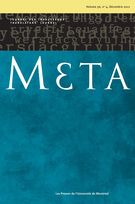This book is based on Torikai’s Ph.D. thesis which was submitted in December 2006 to the University of Southampton. In this book, the author brings light to the role of interpreters in the arena of intercultural communication. Using the method of oral history, the author brings actual interpreters’ life stories to the fore in order to make clear what these interpreters experienced and thought about during their careers. The main research questions asked throughout this book are as follows: 1) “What kind of people became interpreters in post-WWII Japan?”; 2) “How did they perceive their role as interpreters?”; and 3) “What kind of role did they actually play in Japan’s foreign relations?” By exploring in depth what the five pioneer interpreters recounted, she is able to display the complex nature of answers to these questions. This book can be useful and informative for a range of readers including educators and trainers of interpreters, students who are studying interpreting or researchers in Interpreting Studies, scholars whose academic fascination lies in the history of interpreting and intercultural communication, and those who are simply interested in learning more about interpreting, a profession that is often considered invisible. This book is the first of its kind on interpreting history in post-WWII Japan and provides new directions in Interpreting Studies. There are seven chapters in total. In the first chapter, the introduction, the author introduces the general development of interpreting as well as rationales for using oral history as a core method for this study. The chapter also provides background information on the five chosen pioneer interpreters. The second chapter presents a brief history of both interpreting and translation specifically in Japan, connecting the distant past to post-WWII situations. In chapter three, the author analyzes the habitus (in Pierre Bourdieu’s sense) of the five pioneer interpreters in Japan with a focus on how they learned English or grew up bilingual as well as their experiences of WWII. In chapter four, she further analyzes each habitus at the entrance to the world of interpreting and how these interpreters established themselves as specialists in intercultural communication in post-WWII Japan. The fifth chapter provides details about what these interpreters experience in the field of interpreting. The interpreters’ actual recounts in this chapter vividly illustrate their experience as professional interpreters in Japan during the period in which the country was progressively developing as a member of the global community. This chapter is at the core of this book and shows readers the authentic world of interpreting. It is notable that these five interpreters had very different experiences. As well, their perceptions and understanding of interpreters’ roles also varied significantly. In chapter six, the author explores insights into the practice of interpreting and interpreter’s roles in relation to the issue of intercultural communication while drawing on the findings from Claudia Angelelli’s 2004 study on the role of interpreters. This chapter reveals that an interpreters’ role is generally understood as that of kurogo, “the supposedly invisible help” on the stage of kabuki theatre (p. 154). This analogy is effectively expressed by one of the interpreters in this study as the following: “[kurogo] should not dance himself in the limelight. He can, however, help an actor on stage, by adjusting the hemline” (p. 174). In other words, in the minds of the interpreters interviewed, the interpreters’ role is supposedly invisible but is a vital part of communication. Finally, in the last chapter, Torikai draws the conclusion that the habitus of the interpreters and their field of interpreting were quite diverse. She also concludes that it is implausible to …
Torikai, Kumiko (2009): Voices of the Invisible Presence. Amsterdam/Philadelphia: John Benjamins, 197 p.[Record]
…more information
Yukari F. Meldrum
Edmonton, Canada

